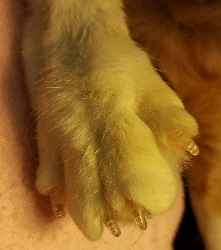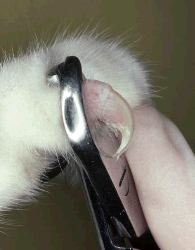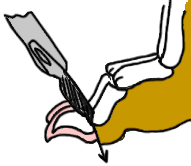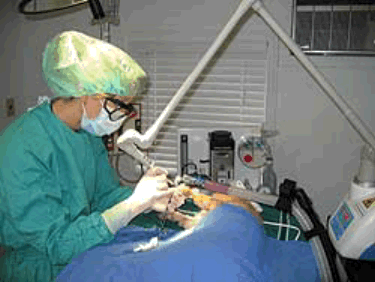|
DECLAWING AND ITS ALTERNATIVES

|
Declawing (also known as "onychiectomy") has probably become the most controversial of all the elective surgical procedures commonly performed by veterinarians. While it is normal for cats to scratch things (to mark territory as well as to condition their claws) this behavior can destroy the bond between an owner and pet cat. Cats, especially adolescent cats, have a tendency to "play rough," scratching their owners or other pets sometimes violently in play. Claws serve to mark territory and assist in communicating territorial messages to other cats though this behavior can be undesirable when it is directed against furniture. The declaw surgery represents an instant permanent solution to these problems; however, it is popularly held that a number of adverse conditions result from declawing possibly including chronic pain for the cat. Pet owners need an understanding all of the alternative options involved as well as what the actual facts are regarding this procedure.
|

(original graphic by marvistavet.com)
|
|
|
The following is the policy of the American Veterinary Medical Association regarding Declawing:
The AVMA discourages the declawing (onychectomy) of cats as an elective procedure and supports non-surgical alternatives to the procedure. The AVMA respects the veterinarian’s right to use professional judgment when deciding how to best protect their individual patients’ health and welfare. Therefore, it is incumbent upon the veterinarian to counsel the owner about the natural scratching behavior of cats, the alternatives to surgery, as well as the details of the procedure itself and subsequent potential complications. Onychectomy is a surgical amputation and if performed, multi-modal perioperative pain management must be utilized. |
|
|
ALTERNATIVES TO DECLAW SURGERY TO TRY FIRST
TRAINING: A NON SURGICAL WAY TO SAVE THE FURNITURE
Scratching is a natural behavior of the cat which makes it very difficult to modify. The usual goal is to transfer the cat's scratching instinct to a scratching post or other scratching toy; it is virtually impossible to control the desire to scratch completely. Some cats take quickly to alternative scratching surfaces while other cats require time-consuming training. The following are training tips:
- Cats seem to prefer to scratch upholstery with a vertical drag to the fabric. Furniture can be upholstered in an unacceptable fabric and a scratching post can be swathed in an appropriate fabric (rather than the usual carpet).
- Furniture can be made unacceptable by using plastic, double stick tape or aluminum foil to cover the target pieces. Spray-on antiperspirants can be sprayed on the furniture as a repellent.
- Treats or catnip can be used to attract the cat to the scratching post.
- The cat can be punished for furniture scratching attempts but it is important that the cat not connect the punishment with the person administering it (otherwise the cat will simply learn not to scratch while that person is watching). Yelling, spanking, or shaking a can with pennies in it is too directly associated with the person rather than the act of scratching. A water squirt bottle is better but only if the cat does not see where the squirt comes from. Booby traps can be set up using balloons. If mouse traps are used, it is vital that they be turned upside-down so that the cat cannot possibly catch a foot in the trap. Stacked traps can be set up so that they pop upward when tripped, making a surprising noise. In this way, punishment can still be carried out when the owner is not at home. The idea is to convince the cat that the furniture piece is not a good area for scratching and that the appropriate scratch toy can be used with no adverse experience.
|

(original graphic by marvistavet.com)
|
Many owners are not excited about putting mousetraps up against their living room furniture, upholstering in aluminum foil, or decorating sofas and chairs with balloons. It is easy to see why a surgical solution would be attractive. Fortunately, there are more options.
NAIL TRIMMING
For some cats, simply keeping the nails short is adequate control but many people do not know how to trim their cat's nails. In fact, the non-pigmented nail of the cat makes it easy to see where not to cut. Here is a video presentation showing exactly what to do:
(or click here to watch this video on its YouTube page)
|
BLUNT ACRYLIC NAIL CAPS
This is another popular method of controlling a scratching problem. Blunt acrylic nail caps are glued onto the cat's claws. The idea is that the blunt nail will not be sharp enough to cause damage. The hospital staff can place the first set or the owner can place the caps him/herself at home.
|

|

A rear paw wearing Soft Paws™.
(original graphic by marvistavet.com)
|
WHAT TO EXPECT
- The nail caps will wear off but not at the same time. After a couple of weeks some of the nails will be capped and others will not be.
- The nail caps must be replaced as the nail grows out.
- Some cats are not in the least discouraged from scratching by these caps and are able to simply scratch larger holes in the upholstery.
For further resources on dealing with claws at home, visit:
https://catfriendly.com/cat-care-at-home/living-clawed-cat
SURGICAL DECLAW (ONYCHIECTOMY)
Despite our best efforts to deflect scratching or decrease claw sharpness, sometimes nothing works and an immediate permanent solution is needed. It is important to consider that the declaw surgery alters the cat permanently and should not be done if alternative methods are effective. The cat will need some special care during the post-operative healing period: special litter, pain medication, and some activity restriction as he/she will have tender feet for a week or two after surgery. The declawed cat should be forever indoors or outdoors only with supervision as he/she will no longer have the ability to defend him/herself against dogs or other cats.
There is a great deal of controversy regarding this procedure and it has been legally restricted in many areas. Few veterinary surgeries encounter as much bias as the declaw, and a political movement has emerged. Some concerns are valid and some less so. Before making a declaw decision, it is important to review the arguments and find your own perspective. Here are some of the issues that are discussed:
MYTHS AND RUMORS AND FACTS
Here are some of the issues that are discussed:
- The declaw is viewed by many as performing an unethical surgical alteration of a companion animal for the sake of convenience. This is frequently countered by the idea that convenience is not the issue but that the relationship between the pet and its owner is at stake. If that relationship fails, a much bigger life quality issue is at stake including cat relinquishment to the shelter where euthanasia is a real possibility.
- Chronic pain may result from alterations in the foot anatomy and that long term arthritis is promoted. While there may be truth to this, it is important to realize that 90% of cats over age 10 have arthritis in at least one joint. While it is certainly better to prevent arthritis in a cat's senior years if we can, we still need the cat to get to its senior years. Arthritis can be treated; euthanasia cannot.
- Some people believe that the indoor only lifestyle of the cat is not humane because it is not natural or an indoor only lifestyle may be impractical because of other people or other animals coming and going in the home. It is true that a declawed cat should become an indoor only pet for its own protection.
- There is belief that the procedure is performed too casually and that alternatives are not properly given consideration. Regardless of one's feelings are on whether to declaw a cat, the fact remains that we are talking about a permanent alteration of the cat with a potential for negative ramifications later on. This is not to be done lightly and it is important to at least attempt some of the alternatives discussed above.
Research has been conducted to sort out truth from political propaganda. The AVMA has an excellent source where this research has been collated and the concerns are addressed. Here are some conclusions but feel free to examine the AVMA's information on your own.
MYTH #1: After declawing, a cat is likely to become fearful or experience behavior changes, impairing an affectionate relationship with his owner.
Numerous scientific studies have been unable to document any behavior changes post-declaw. In fact, in one survey 70 percent of owners of declawed cats reported an improved relationship with their cat after the procedure.
MYTH #2: A declawed cat cannot climb trees.
Declawed cats are not as effective at climbing trees as cats with claws, but declawing does not prevent tree climbing. That said, declawed cats should be kept indoors where they do not need claws to assist in self-defense.
MYTH #3: A declawed cat cannot catch prey.
Declawed cats are not as effective at catching prey as cats with claws but declawing does not prevent effective hunting.
MYTH #4: A declawed cat has lost its ability to defend itself and should not be allowed outside.
This one is true. Without claws, a cat has indeed lost an important part of his defense system. Declawed cats should be housed indoors only.
MYTH #5: Declawed cats are more likely to bite since they can no longer claw.
Declawed cats do not seem to realize they have no claws. They will continue to scratch ineffectively as if they did not know the difference. As for biting, there have been some studies that show an increased tendency to bite in declawed cats while other studies have not shown that. The trouble in interpreting this information is that one of the reasons cats are declawed is to control aggression. Cats that are aggressive (even in play) are more likely to be declawed to at least remove the claw portion of the human hazard. The same cat is still perfectly able to bite and will continue to bite. Studies on cats that bite after declaw have not explored whether the same cats were biting before the declaw so conclusions are difficult to draw.
MYTH #6: The post-operative period involves tremendous pain.
Pain management techniques have improved greatly in recent years and include regional nerve blocks eliminating pain completely from the feet during the first few days of healing, fentanyl pain relief patches, as well as injectable and oral medications. This means that a declawed cat should be comfortable in the recovery period.
That said, if proper pain relief is not practiced, the declawed cat will have sore feet after surgery. The larger the cat, the more discomfort there is and reluctance to bear weight.
The recovery period should not last longer than a week or so. Healing should be complete by two weeks. Pain after this recovery period is not normal or expected in any way and if a declawed cat seems to be uncomfortable or lame, a recheck appointment is definitely needed.
If you plan to declaw your cat, you may want to ask your veterinarian about the pain relief plan they expect to utilize so you know what to expect.
MYTH #7: A declawed cat will not use a litter box again.
It is important that litter not get impacted in the declaw incisions during the recovery period. Shredded paper is the usual recommendation during recovery and some cats simply will not use shredded paper. The recycled newspaper litters are an excellent alternative. The only litter problem one might expect would be lack of acceptance of a new litter during the recovery period. Declawed cats do not loose their litter box instinct.
DECLAW METHODS
There are three techniques commonly utilized for permanent declaw surgery: the "Resco" or Clipper Blade method, the Disarticulation method, and the Laser declaw.
DECLAW: THE RESCO CLIPPER METHOD
|
This is probably the most common method used by veterinarians to declaw cats as it is associated with the fastest surgery time. It involves the use of a sterile nail trimmer to cut through the bone of the third digit of the toe. The cat loses the part of the bone from which the claw grows. The incision is either sewn closed with suture material or closed in surgical glue but a small piece of bone is retained to maintain the tendon connections to the toe.
WHAT TO EXPECT / POSSIBLE COMPLICATIONS
- Patients commonly spend at least one night in the hospital for bandaging, monitoring for bleeding and pain assessment.
- Some spotting of blood is normal from the toes during the first few days at home (beware if white carpeting is present).
- Shredded paper or pelleted recycled newspaper litter is recommended during the healing period. Conventional clay or sand litters can impact inside the tiny incisions and cause infections.
- Pain medication is essential, especially for larger or older cats who have more weight to carry on their tender healing toes. The amount of weight carried on the feet (the size of the cat) is the biggest factor in post-operative pain. There are numerous regimens employed for declaw pain control.
- Occasionally not enough of the third bone is removed and the claw regrows. When this occurs, infection is generally inevitable and the remaining bone must be removed. This is not a potential complication when the disarticulation method is employed.
- A study by Martell-Moran et al published in the Journal of Feline Medicine and Surgery in 2017 found that cats declawed with this method had more back pain later in life than disarticulated cats or undeclared cats.
|
 (Photocredit: Dr. Barbara Stein and VIN) (Photocredit: Dr. Barbara Stein and VIN) |
|
DECLAW: THE DISARTICULATION METHOD
This procedure is a bit more difficult to master as it involves the delicate disconnection of all the tiny ligaments holding the third bone in place. The entire third bone is removed in its entirety.
|

(original graphic by marvistavet.com)
|
WHAT TO EXPECT / POSSIBLE COMPLICATIONS
- Because the entire third bone is removed, there is a zero possibility of the claw growing back; however, the cut ligaments allow for a subtle drop in the way the foot is held. Most owners do not notice this change in posture.
- As with the Resco method, patients commonly spend at least one night in the hospital for bandaging, monitoring for bleeding and pain assessment.
- Some spotting of blood is normal from the toes during the first few days at home (beware if white carpeting is present). Disarticulation is associated with more bleeding than the Resco method.
- Shredded paper or pelleted recycled newspaper litter is recommend during the healing period. Conventional clay or sand litters can impact inside the tiny incisions and cause infections.
- Pain medication is essential, especially for larger or older cats who have more weight to carry on their tender healing toes. The amount of weight carried on the feet (the size of the cat) is the biggest factor in post-operative pain. There are numerous regimens employed for declaw pain control.
THE LASER DECLAW: ANOTHER WAY TO DISARTICULATE

Recently, the “laser declaw” has received a great deal of attention. In this surgery, a laser rather than a scalpel blade is used to disarticulate the third toe bone. Advantages of laser surgery include virtually no bleeding (during surgery or afterwards), possibly less post-operative pain, and in many cases, no bandages.
The downside is the expense of the equipment. The cost of the laser equipment itself: $20,000 - $40,000. To justify such an expense, the laser must be able to generate substantial revenue for the veterinary hospital. This means that the cost of the laser declaw to the pet owner is likely to exceed the price of the conventional declaw by an additional $50 to $150 dollars.
To find a veterinarian who offers laser declaw, you can contact the laser companies directly.
https://www.aesculight.com/pet-owners/locate-a-veterinarian/
https://celasers.com/veterinary/for-pet-owners/(scroll to the bottom to locate a veterinarian)

TENDONECTOMY: A SURGICAL ALTERNATIVE TO DECLAWING
This surgical procedure has emerged as an alternative to the bone removing declaws. Here, a tendon is cut on the underside of each toe to prevent grasping motions. The claws remain but the cat cannot extend them.
|
WHAT TO EXPECT / POSSIBLE COMPLICATIONS
- Because the incisions needed for this procedure are so small, the recovery is minimal. No bandages, no special litter, no blood spotting. There are usually no stitches to remove and the tiny incisions are closed in surgical glue.
- Because the cat can no longer make grasping motions, the claws will naturally grow in a circular manner into the foot pads causing pain and infection unless the owner is able to trim the nails on a regular basis. (The tendonectomy patient will require life-long management in the form of regular nail-clipping). This may not be practical in an aggressive cat and may not be the right choice for an owner seeking a "low maintenance" pet.
|

In the tendonectomy a small incision is made under each toe and a section of tendon is clipped out.
(original graphic by marvistavet.com)
|
The August 1, 1998 issue of the Journal of the American Veterinary Medical Association reports a study to compare the long and short term complications of tendonectomy vs. those of traditional declaw. Owner satisfaction with both procedures was also measured. While cats who received the tendonectomy showed significantly lower pain scores immediately post operatively, both procedures showed an equal frequency of other complications (bleeding, lameness, and infection). The number of days it took for a cat to walk normally again was not different between the declawed cats and the tendonectomy cats. There was no significant difference between the percentage of owners satisfied with declaw versus the percentage of owners satisfied with tendonectomy. In a 2001 survey, more people were satisfied with the declaw over tendonectomy.
The most important thing in making a claw management decision is making a decision
that you have considered mindfully and will promote the best relationship with your cat.
There are positives and negatives with each procedure.
|

|
On November 20th, 2009 the city council of Los Angeles voted to ban declawing which means that our hospital will no longer be performing this surgery. As of December 12th, 2009 the following cities in California have banned declawing: Los Angeles, Culver City, West Hollywood, Beverly Hills, Santa Monica, San Francisco, and Berkeley. In the Los Angeles area, declawing is legal in Malibu and Marina del Rey as well as in cities not listed above. Since 12/31/2009 it has not been legally possible for a municipality to ban any medical procedure that the state of California has sanctioned.
|

Page last updated: 9/3/2021
|